At first glance, the annual Geminid meteor shower appears to be on a collision course with a bright Moon. But a closer look reveals a happy window of dark skies.
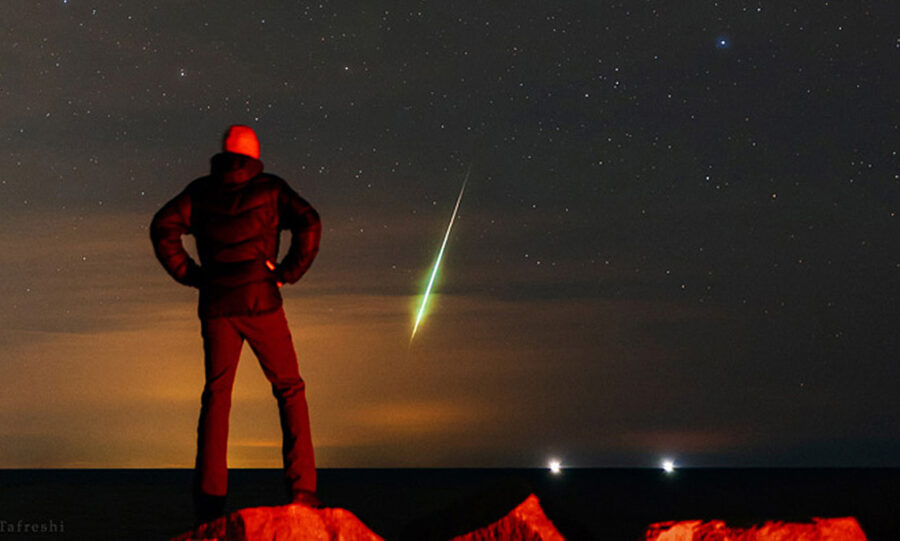
Babak Tafreshi
The Geminids are coming! While the meteor shower is the year's richest it also happens to occur under the glare of the waxing gibbous Moon. Normally, this would spell doom for viewing any but the brightest meteors, but thanks to winter's long nights, a choice observing window opens up in the small hours after moonset.
The shower peaks on Monday night–Tuesday morning December 13–14 with up to 120 meteors per hour visible from a perfectly dark location. Observing from a semi-rural sky I typically see about half that number. Most arrive singly, but sometimes two or three zip by in succession followed by several minutes of inactivity. These quiet spells only increase the suspense and seductively stretch a one-hour meteor-watching session into one lasting twice as long.
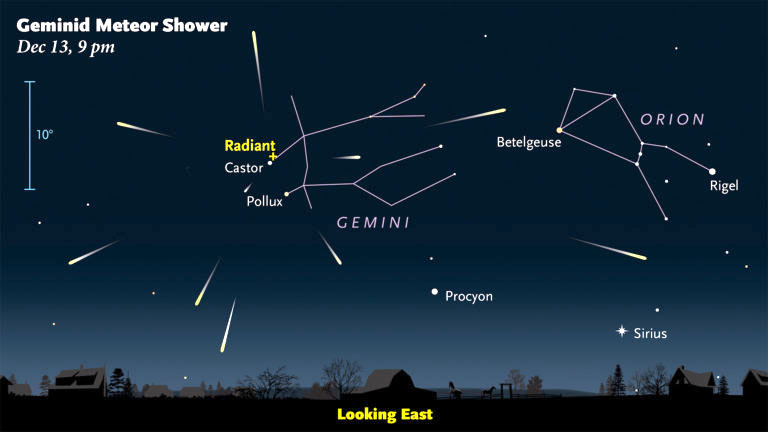
Gregg Dinderman / Sky & Telescope
During the evening portion of the shower, a 79-percent-illuminated Moon will shine from Pisces and scrub out the fainter members. But the Geminids possess a secret weapon — fireballs! The shower ranks second only after the Perseids for bright meteors, so expect to see a modest amount of activity during the evening hours despite moonlight.
Geminids stream from a radiant or point in the sky located just a couple degrees southwest of the bright star Castor in Gemini, the Twins. As the Earth wings around the Sun at some 107,000 kilometers per hour, it encounters the trail of debris spalled from the asteroid 3200 Phaethon, the Geminids' parent. Like a car plowing through a snowstorm at night, we barrel straight into the material, which creates the illusion of meteors streaming from a point in the sky.
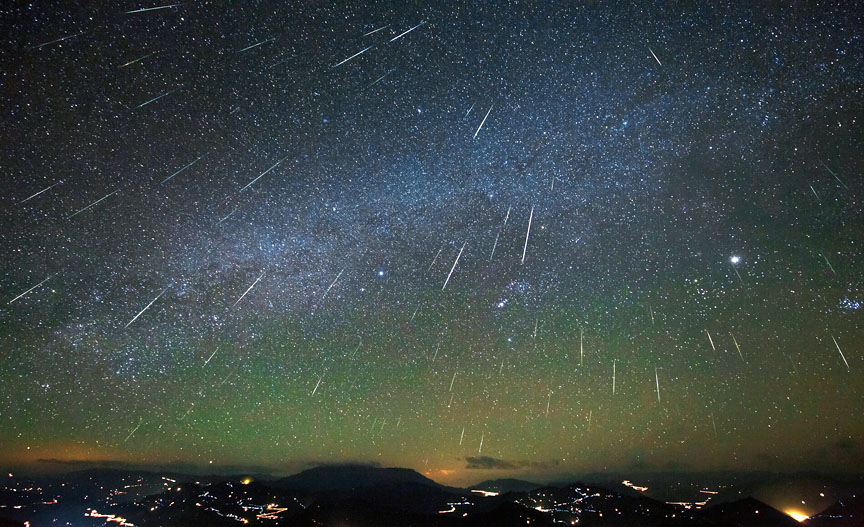
Copyright Jeff Dai
In reality, the fragments strike our atmosphere on approximately parallel paths. The combined speeds of the Earth and shower material add up to an average incoming Geminid speed of around 127,000 kilometers per hour, fast enough for friction with the air to heat and vaporize the particle, creating a luminous trail several kilometers long of ionized metals (including iron and magnesium) and atmospheric molecules. Heating and ionization combined create the familiar sight most people know as a "shooting star."
Moon or no, you can start watching the shower as soon as twilight's end on December 13th, when the radiant has barely risen in the northeastern sky. That's when Geminid earthgrazers will be on the prowl — meteoroids that strike the atmosphere at a very low trajectory and produce long-lasting, often bright trails. I've only seen a few of these over the years, but each has been memorable.
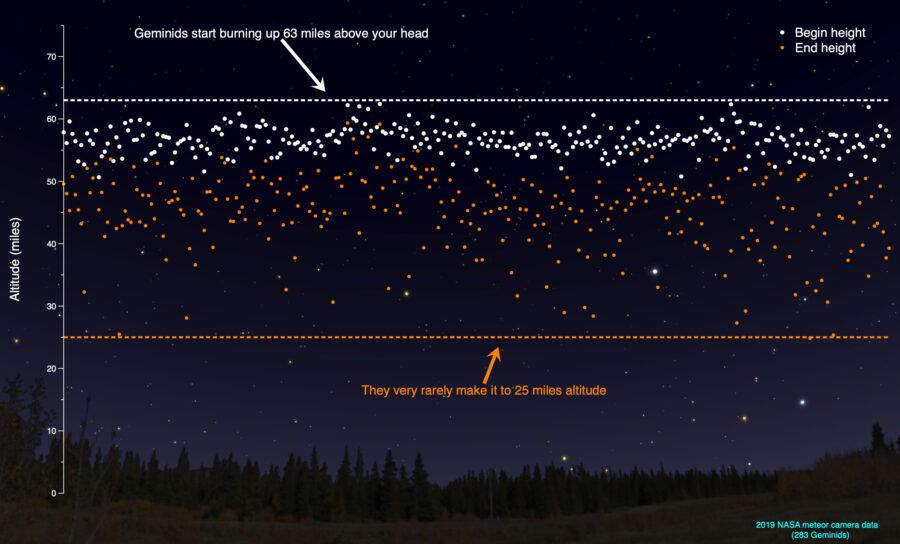
NASA
By 9 p.m. local time, when the radiant has risen to around 30°, you can begin observing in earnest. Just remember that lunar glare will reduce the meteor count. For the best view, observe with the Moon at your back to preserve your night vision. This year, the International Meteor Organization is asking for help in determining the effect of bright moonlight on meteor activity. You simply need to observe the shower for at least one hour and estimate your limiting magnitude every 30 minutes by counting the number of stars visible within certain areas of the sky. You'll find charts for these areas here, with Field #7 on Chart 1 easiest to use. Complete the free registration form and then submit your report here.
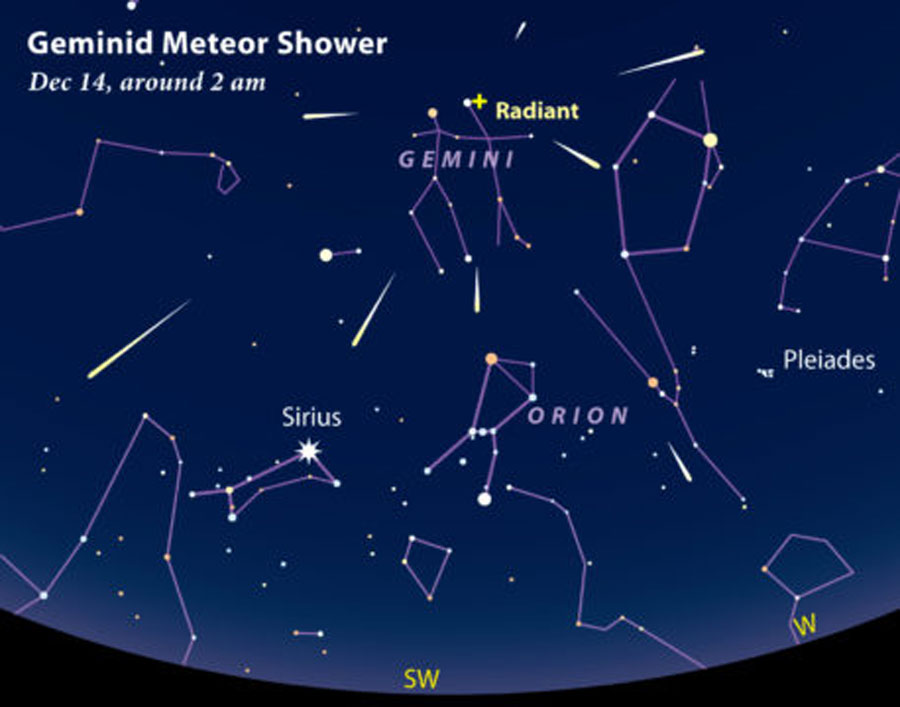
Sky & Telescope / Gregg Dinderman
The best show begins around moonset (approximately 3 a.m. local time on December 14th). For the next few hours before the start of dawn, Gemini towers in the southwestern sky, with the Geminids at full force. As often happens in our hobby, the best observing hours coincide with the coldest temperatures of the night, making this year's shower a bit more challenging than usual. Dress warmly. Use chemical handwarmers inside your boots and gloves and keep a hot beverage at the ready. A lounge-style chair you can settle into comfortably is a must. No one says that amateur astronomy necessitates a spartan life style. Creature comforts make us better observers.
As with most meteor showers, the great majority of Geminids are small, ranging from dust- to pea-size, but occasionally larger pebbles shed by the asteroid produce brilliant fireballs, which are meteors that equal or exceed the brightness of Venus (magnitude –4).
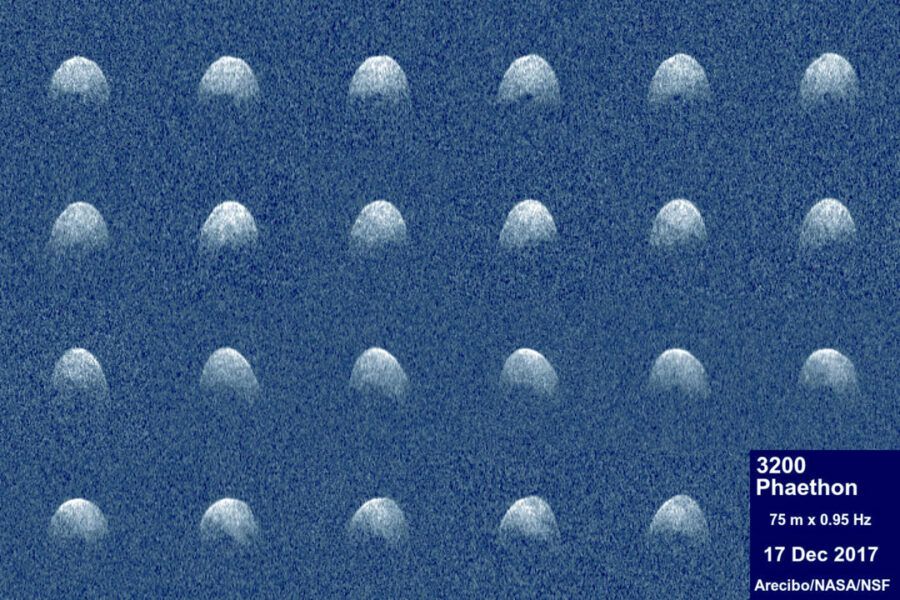
Arecibo Observatory / NASA / NSF
The Geminid stream stands apart from other showers because it originates from 3200 Phaethon, a 5.8-kilometer asteroid with a cometary orbit that occasionally sprouts a dust tail. Most meteor showers instead stem from comets. Phaethon swings closer to the Sun than any other major asteroid, leading astronomers to hypothesize that intense solar heating causes its surface to crack and release dust and rocks that create and feed the Geminids. Earth cuts across Phaethon's orbit during the first three weeks of December, and we blast through the core on December 13–14, the reason for the rapid increase in activity on those dates.
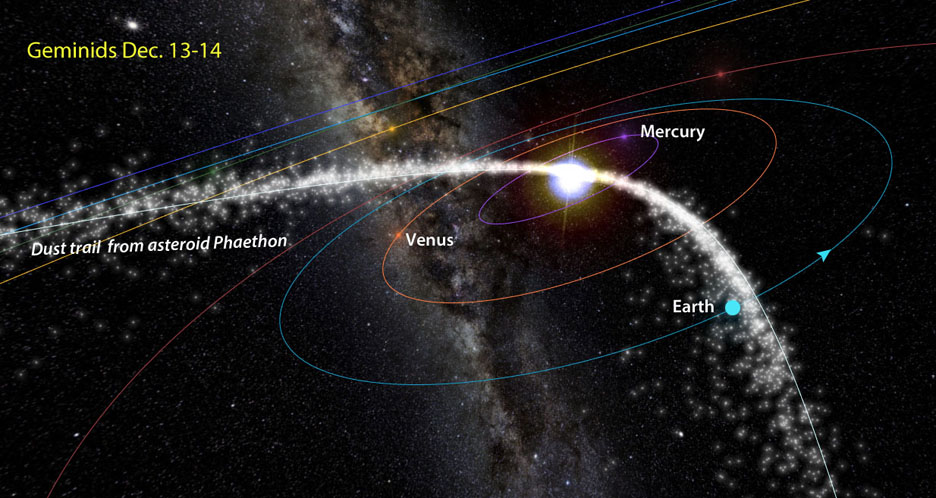
Data by Peter Jenniskens and visualization by Ian Webster
As far as the best direction to face to view the shower, keep the radiant off to one side of your vision. That way you'll bag a mix of both short-trailed meteors and the "long-streakers" that flare 90° to either side of the radiant. For the Geminids I like to face southeast during the evening hours and south or northwest before dawn. But don't fret — Phaethon's fragments will cross the sky in all directions. And you can identify any meteor as a Geminid by following its trail backwards. If it points to Castor, you've got a keeper.
 9
9








Comments
KHartnett
December 10, 2021 at 5:19 pm
I happened to attend an excellent Goddard Scientific Colloquium lecture by Dr. David Jewitt this week on the Geminids and their connection with the asteroid Phaethon. While he and his colleagues have used NASA's Stereo spacecraft to confirm that Phaethon sheds dust at perihelion, very sensitive observations at other times in its orbit have apparently failed to show sufficient shedding to replenish the amount of material needed to fully account for the Geminids. So there's a measure of mystery with this grand show! A paper by Jewitt and Li is here: http://www2.ess.ucla.edu/~jewitt/papers/2010/JL10.pdf
You must be logged in to post a comment.
Bob KingPost Author
December 13, 2021 at 11:02 am
Dear KH,
I recall hearing that somewhere, so I appreciate the link you provided to the study. Thank you!
You must be logged in to post a comment.
ErnieOstuno
December 13, 2021 at 5:42 am
Saw 4 Geminids from 0830 UTC to 0845 UTC on 12/13 in a light polluted area on the outskirts of Grand Rapids, Michigan. The moon was down but the limiting magnitude was around 4. I would estimate all the meteors I saw were brighter than 2nd magnitude and two were brighter than 1st magnitude. Given the limiting factors I would guess the ZHR was >60. I went back out an hour later and saw none from 930 UTC to 950 UTC.
You must be logged in to post a comment.
Bob KingPost Author
December 13, 2021 at 11:03 am
Hi Ernie,
Sounds like a good start. I peeked out the window this morning and saw three in about 15 minutes. All bright!
You must be logged in to post a comment.
ErnieOstuno
December 14, 2021 at 5:31 am
Observed from the same spot from 0830 to 0900 UTC and saw 4 more. Three of them were estimated second magnitude and in the same area, northwest of Alphard, Alpha Hydrae on similar trajectories. Went out again from 1000 to 1015 UTC and saw three more, including a couple 0 magnitude beauties, one low on the western horizon in Taurus and another streaking from just northeast of Betelgeuse into Monoceros. From a dark sky site this would have been a decent shower, even with the cold, damp air putting down a layer of frost on my parka.
You must be logged in to post a comment.
AKskywatcher
December 13, 2021 at 2:47 pm
We live in Alaska and the night sky is visible for much longer than in the lower-48. This morning at 0600L, my wife was out walking and saw a large "fire-ball" in the ENE moving north to south. It was short-lived but very striking.
You must be logged in to post a comment.
Henrik
December 14, 2021 at 4:09 pm
Hi Bob, thanks for a nice article, as always.
In December we in Sweden are clouded out 99% of the time. This evening it is cloudy, but I can see the moon through the clouds. Just as I was crossing the yard from the toolshed to the summer house (well, the winter house at this time) in the archipelago outside Stockholm, I looked up as I always do when outside. And I happened to see a meteor through the clouds. Undoubtedly a Gemenid since it came from the NW. I have seen lots of shooting stars and quite a few fireballs, but never a meteor through the clouds.
Best regards,
Henrik
You must be logged in to post a comment.
Henrik
December 14, 2021 at 4:10 pm
Sorry, should have written NE.
Henrik
You must be logged in to post a comment.
Joe Stieber
December 16, 2021 at 12:44 am
I observed from the New Jersey Pinelands on the morning of December 14, 2021, from about 1:45 am to 6:15 am EST (moonset at 2:50 am, astronomical twilight began at 5:35 am). This is a Bortle 4 to 5 site and there were some passing thin clouds, but it was largely clear during that time. I saw a total of 150 meteors, of which maybe half a dozen were obvious sporadics. There were at least half a dozen fireballs and at 5:47 am, a bolide, which reached magnitude -6 to -8 and fragmented at the end. One of my best meteor observing sessions!
You must be logged in to post a comment.
You must be logged in to post a comment.